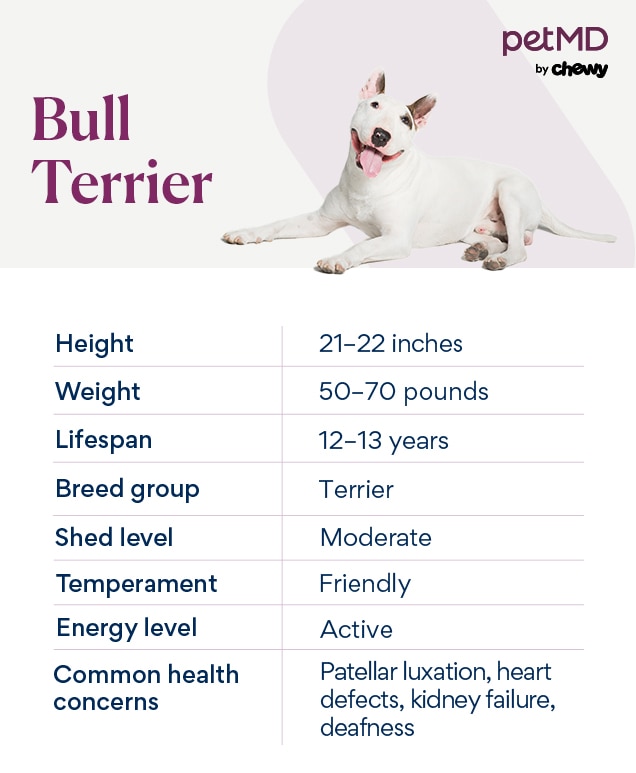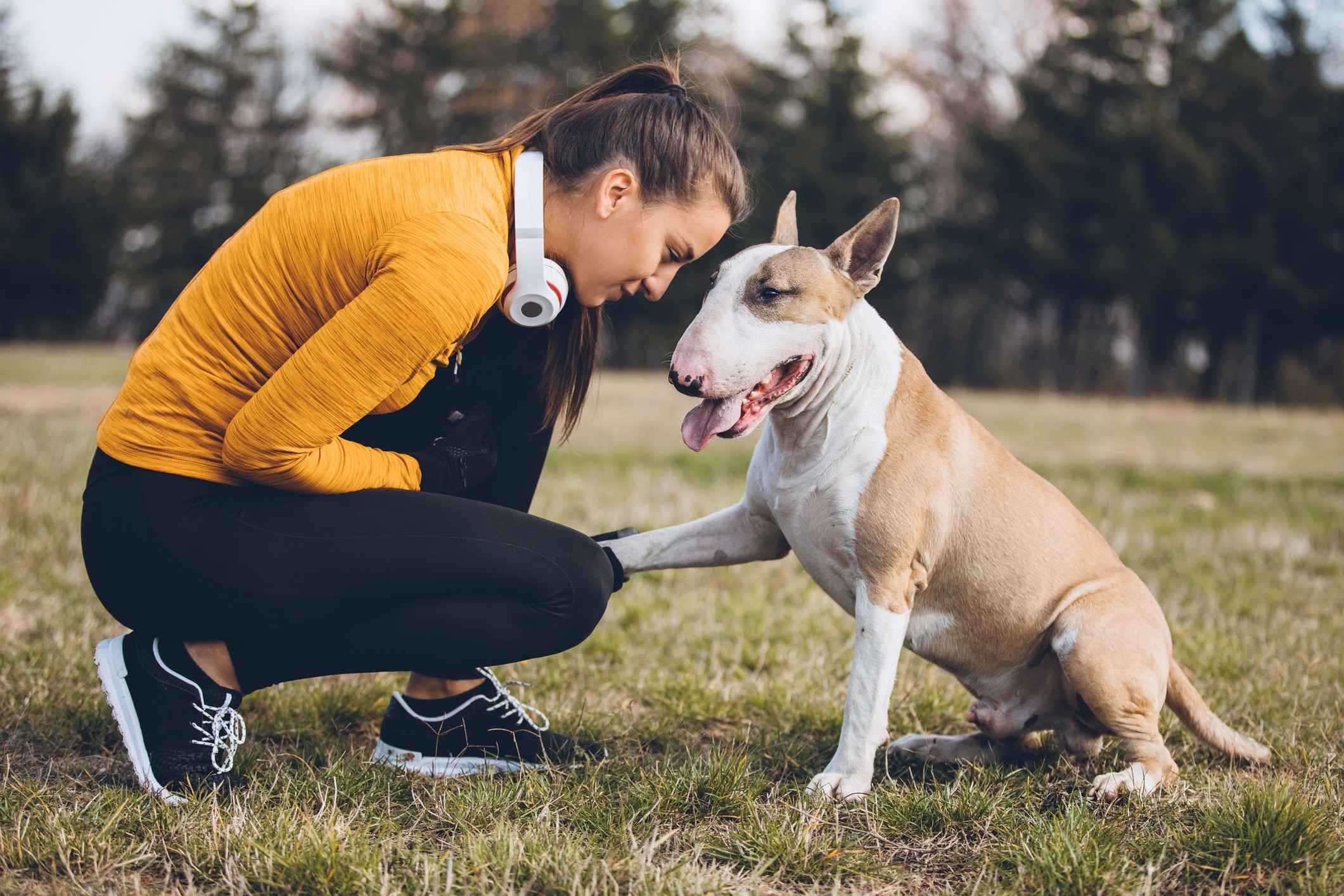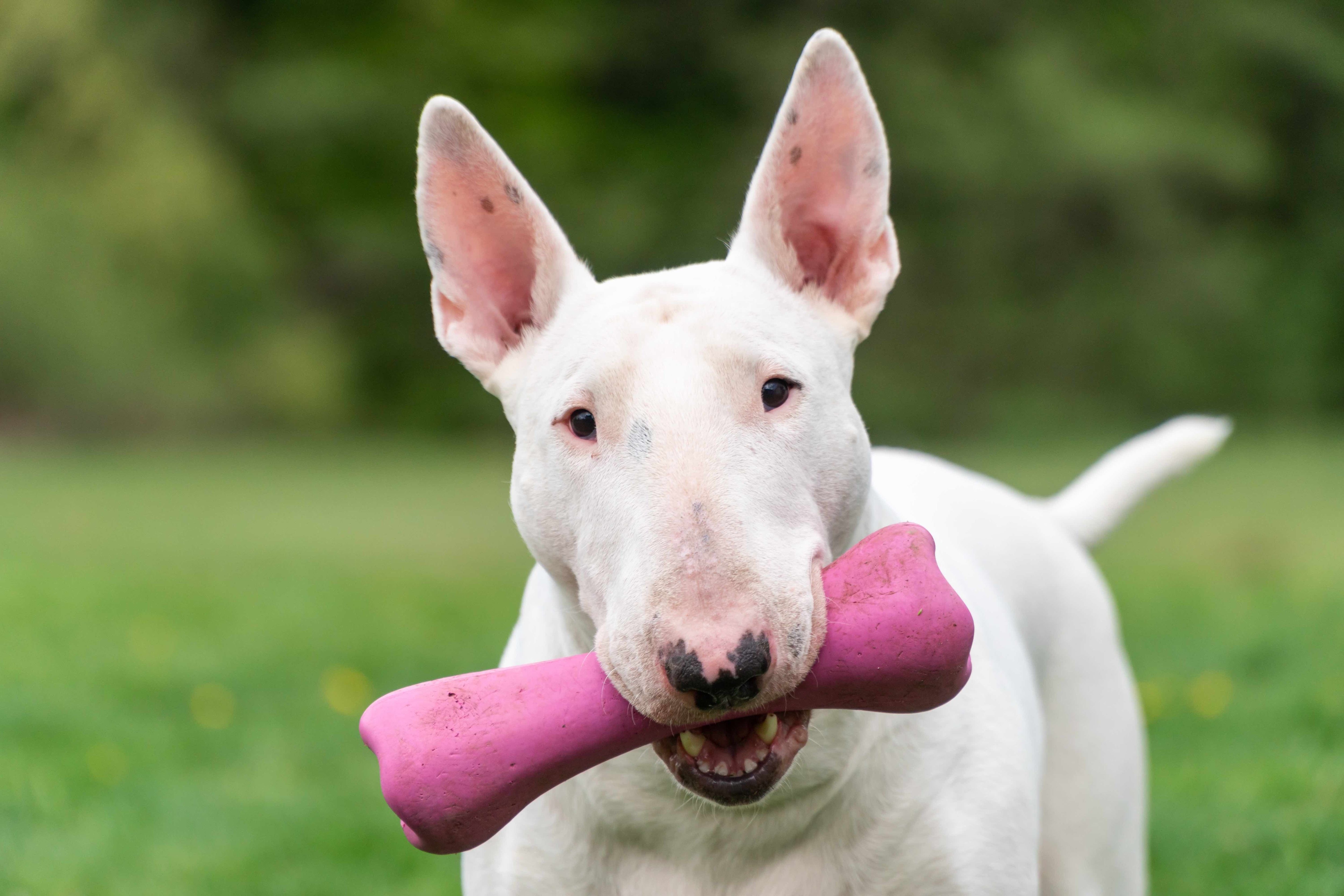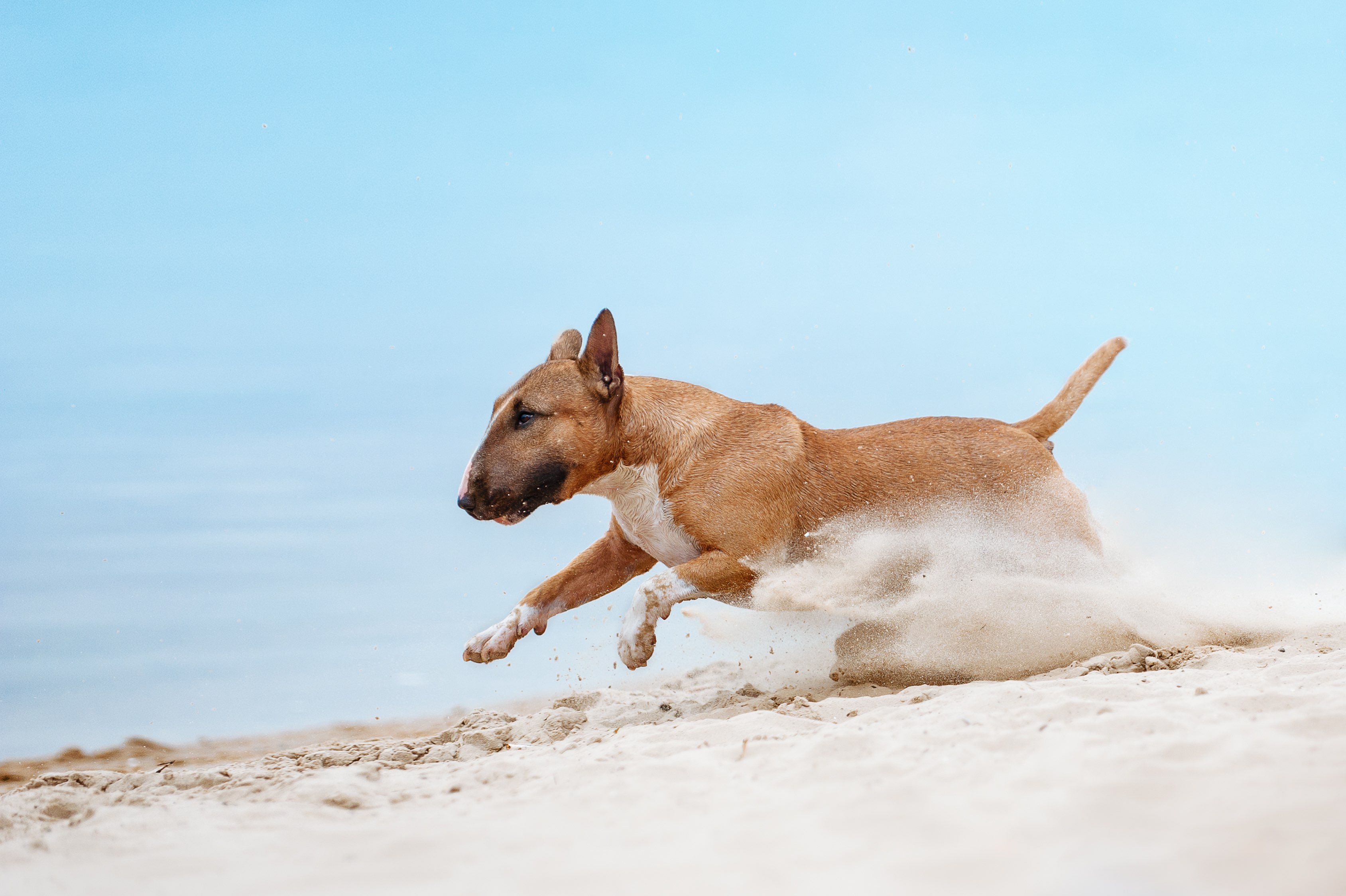Bull Terrier
iStock/Marco_Piunti
While the Bull Terrier isn’t among the most popular dog breeds in the United States, they’re certainly one of the most recognizable thanks to their egg-shaped heads, triangular eyes, and muscular bodies. (Not to mention that the Bull Terrier has frequently been in the public eye as the Target dog). The Bull Terrier’s athletic build generally reaches a height of 21–22 inches, and they weigh in at around 50–70 pounds.
This stocky dog breed was recognized by the American Kennel Club (AKC) in 1885, and despite their unfortunate beginnings in bull-baiting, Bull Terriers are a sweet and lovable breed. For those prepared to provide them with the attention and training they need, Bull Terriers make wonderful family dogs.
Caring for a Bull Terrier

The Bull Terrier is playful, athletic, and generally low-maintenance—as long as they get plenty of interaction with people. “They’re easy to engage in exercise and are happy to greet each new day,” says Kim Bebb, president of the Bull Terrier Club of America. “They thrive on being one of the family.”
That being said, Bull Terriers are still a member of the terrier group, and with that comes a certain amount of energy and independent thinking. So it’s important to provide this breed with physical and mental stimulation as well as consistent positive reinforcement training. Early socialization and obedience training will go a long way toward ensuring your Bull Terrier puppies grow into well-mannered family members.
Bull Terrier Health Issues

Bull Terriers typically have a lifespan of 12–13 years and, according to the Bull Terrier Club of America, there are a few health issues that pet parents should note.
Official health concerns aside, it’s important to note that this breed tends to eat and chew on anything that’s around—which can easily lead to an intestinal blockage. “Many Bull Terriers have had at least one ‘zipper surgery’ in their lifetime,” Bebb says, referring to the incision veterinarians make near a blockage site to retrieve the object, leaving behind a scar that looks like a zipper. For that reason, pet insurance may not be a bad idea with this breed.
Patellar Luxation
Patellar luxation is a condition in which the kneecap (or patella) shifts out of place. The most common and noticeable symptom is when a dog suddenly lifts one hind leg, sometimes yelping. This is often called a “skip” or “hop” and it generally comes and goes.
Patellar luxation is usually diagnosed with a physical exam where a veterinarian manipulates the back limbs with one of their hands over the knee to feel the patella luxating, says Dr. Yui Shapard, BVM&S, Educational Director for the Association of Asian Veterinary Medical Professionals. Based on that exam, they’ll grade it from mild to severe.
“Treatment is based on how this is affecting the patient, and in many mild cases no treatment is required,” Dr. Shapard says. “In severe cases, a surgical correction may be required—especially if it is affecting the patient’s quality of life.”
Another common recommendation is an omega-3 supplement for mild cases, which she says can provide anti-inflammatory relief that can be given long-term. Glucosamine supplements in addition to MSM are great to help promote joint health and have all natural anti-inflammatory properties as well. They’re recommended to any dog that has joint issues such as luxating patella.
Mitral Valve Dysplasia
Mitral valve dysplasia is a congenital defect of one or more components of the mitral valve complex that leads to congestive heart failure. It’s often indicated by a heart murmur, which can be identified by a veterinarian through a cardiac exam.
Dogs with this heart valve developmental malformation have valves that don’t close properly, become narrow, and allow a backflow of blood from the left ventricle to the left atrium, which in turn affects the high-oxygen blood flowing from lungs to heart. Symptoms occur directly from the defect itself or secondary to congestive heart failure, and they include:
-
Tiring easily
-
Increased respiratory rate
-
Collapse or fainting
Your vet may diagnose based on these clinical signs, your dog’s lineage, or other tests including bloodwork, blood pressure, radiographs, or even echocardiography or electrocardiogram.
Although there is no cure, there are treatment options for managing symptoms, including hospitalization with oxygen therapy, diuretic therapy, oral medications, exercise restriction, and possible sodium reduction in the dog’s diet.
Hereditary Nephritis
One of the more serious causes of kidney failure in dogs, hereditary nephritis is often seen in Bull Terriers, so make sure to ask your breeder for proof of testing for kidney issues before committing to a Bull Terrier puppy.
Symptoms of kidney failure include poor appetite and increased thirst and urination. Your veterinarian will conduct a urinalysis (ideally on a urine sample taken first thing in the morning, when the sample is most concentrated) to see whether the kidney is filtering what should be filtered and retaining that which needs to be retained, says Dr. Shapard. Blood samples may also be taken to aid in diagnosis.
Unfortunately, by the time a diagnosis of kidney failure is made, patients are often sick enough that response to treatment is too slow to be effective. In some cases, euthanasia may be the most humane option.
Partial or Total Deafness
Certain dog breeds with the merle, piebald, or extreme white piebald genes (like the Bull Terrier) are more likely to be born with partial or total deafness.
“Clinical signs of deafness are a challenge to detect, especially when they are born deaf, as they can still go about their daily lives,” Dr. Shapard says. “[Pet parents] may notice that it is hard to rouse them when asleep or they may notice that their dog appears to have difficulty locating the origin of a sound, and deaf puppies may be more vocal and play more aggressively.”
The brainstem auditory evoked response (BAER) test is recognized as the best hearing test available for hereditary deafness in dogs and can be used to screen puppies as young as 6–8 weeks old, says Dr. Shapard. But your veterinarian may also simply make a loud noise (like a finger snap) out of your dog’s sight and near their ear to diagnose a hearing deficit.
“There are no treatments for this, and those that have been diagnosed as deaf should not be bred as this will carry down its genetic line,” says Dr. Shapard. However, keep in mind that a deaf dog can live a full and happy life without hearing, as long as you’re willing to adjust your training methods to be visual rather than auditory.
What To Feed a Bull Terrier

Bull Terriers should be fed a balanced diet of high-quality dog food, and any commercially available food you choose should be approved by the Association of American Feed Control Officials (AAFCO) to ensure it provides proper nutrition and meets all necessary regulations.
Dr. Shapard adds that, for any dog, the proper food “depends on the life stage and any pre-existing condition that particular dog has.” In general, she says her go-to recommendation will always be based on evidence-based commercial diets, such as Royal Canin®, Purina®, and Hill’s Science Diet®. “All three of these pet food brands employ board-certified veterinary nutritionists to test, monitor, and oversee the nutritional requirements and standards of these diets, for both prescription diets and non-prescription diets,” she says.
She warns that some of the more novel brand diets do not go through the same regulatory safety checks and may not be overseen by a licensed veterinary nutritionist. “There is a lot of misinformation online created by people with no veterinary degree or valid experience, so it is vital for the health and wellbeing of pets to make sure the [parents] are doing their due diligence in finding the right resources,” she says. “And the best way to do that is to reach out to a licensed veterinarian.”
How To Feed a Bull Terrier
Bull Terriers typically love to eat, so feed them a measured amount of an age-appropriate (puppy, adult, or senior) dog food twice a day. Avoid leaving food out all the time, or “free-feeding” them, since these dogs can become overweight quite easily.
How Much Should You Feed a Bull Terrier?
Feed your Bull Terrier following the measurements outlined on their dog food label twice a day. Depending on the food, as well as your dog’s age and size, the total daily amount will likely be between 1⅝ and 4¼ cups. Your veterinarian can give you precise guidance on how much to feed your dog.
Keep in mind that this breed loves to eat and, although they tend to be quite active, they can also put on excess weight if you overfeed or over-treat them.
Nutritional Tips for Bull Terriers
Natural calcium is particularly important for Bull Terriers, especially when they’re young, to support their growth and bone development. Their food alone may be a sufficient source, but if not, talk to your vet about other dog-safe high-calcium foods or supplements you can add during periods of rapid growth.
Behavior and Training Tips for Bull Terriers
Bull Terrier Personality and Temperament

Playful and clownish, the Bull Terrier is an active, energetic dog that Bebb says is “like a 3-year-old child in a dog suit.” They’re generally loving and affectionate, but they don’t save all that adoration for only their family and will happily climb onto the lap of the next person offering a treat and a cuddle—unless they’re feeling independent, in which case, Bebb says, they may want nothing to do with you. And they very well may display all of these attributes within the span of a few minutes.
Although they’re affectionate with family—including children—they are not always dog- or cat-friendly. Early and frequent socialization and training is key, and supervision with small children is always recommended with any breed.
Bull Terrier Behavior
Regular exercise is a must for Bull Terriers. A daily walk is a good start, but this energetic breed may need additional physical and/or mental stimulation to be his best self.
Along with exercise, this friendly pooch needs plenty of human companionship. If left alone for hours, they can make quick work of a couch cushion (or anything else they can get their mouth on), and they’re prone to developing compulsive behaviors, like tail-chasing, if they aren’t given enough attention or stimulation.
The Bull Terrier is playful, athletic, and generally low-maintenance—as long as they get plenty of interaction with people.
Bull Terrier Training
This is not the easiest breed to train, but Bull Terriers have the ability to learn just about anything if they’re properly incentivized. Making training sessions enjoyable and interesting is the key to getting your Bull Terrier to learn good behaviors, but you must be consistent and frequent with your training, starting at the puppy stage.
Bull Terriers may not always pick up on lessons the first time around, but that’s likely due to insufficient motivation and their willful nature, not a lack of intelligence. Despite their need for human interaction, the Bull Terrier is an independent dog. So if you want them to do something, reward them with treats, toys, and belly rubs.
Because they’re such big eaters, dog treats are a fantastic way to keep them motivated, but be careful not to give them so many that they become overweight.
Fun Activities for Bull Terriers
-
Fast CAT (a timed 100-yard dash competition)
-
Obedience training
-
Nose work/tracking
Bull Terrier Grooming Guide

Grooming your Bull Terrier is one of the easiest aspects of living with this breed, thanks to their short coats and healthy ears and eyes.
Skin Care
Some Bull Terriers may develop itchy skin due to allergies (called atopic dermatitis), especially on their feet, belly, folds of skin, and ears. If left untreated, this can lead to secondary infection where the dog has scratched, causing serious discomfort.
There are several possible causes for allergies, ranging from food to indoor and/or outdoor environmental allergens. If you and your veterinarian are able to determine and address the cause, that’s the best place to start. However, it’s more likely that you’ll need to treat the symptoms, in which case your veterinarian might recommend a medicated bath, topical treatment, or oral medication.
Coat Care
While Bull Terriers do shed—quite a lot, according to Bebb—they generally require little more than a quick weekly once-over with a soft-bristled brush. Even when they do get dirty, they tend to ditch much of the dirt they’ve picked up by the time they reach the front door, so baths are rarely necessary. There’s no need to bring in a pro for this pup.
Eye Care
Other than a slight propensity for dry eye later in life, Bull Terriers don’t have special eye care considerations. Talk to your veterinarian if you notice any changes in your dog's eyes or eyesight.
Ear Care
A Bull Terrier typically has healthy ears when it comes to likelihood of infection, and regular ear cleaning with a veterinary-approved ear cleaner should be all that’s required. However, because hereditary deafness is a known issue in the breed, puppies (especially white Bull Terrier puppies) should undergo a brainstem auditory evoked response (BAER) test to check their hearing.
Considerations for Pet Parents

If you’re interested in adding a Bull Terrier to your home, first make sure you’re prepared to truly make them a part of the family. They need a lot of human interaction and can become destructive if left home alone for long periods. They’ll also need exercise, training, and socialization in order to be the nice family dog you want.
Additionally, keep in mind that they’re quite tolerant of heat, but not of cold. If you live in a damp or chilly climate, you’ll need to have coats or sweaters on hand for your dog.
Bull Terrier FAQs
Is a Bull Terrier a good family dog?
Yes—for the right family! Bull Terriers are wonderful with people of all ages and absolutely love being a part of the family, especially if they’re socialized from an early age and receive consistent training. They tend to enjoy lots of petting and snuggling, but these energetic clowns also love to play, so families with active children are a great fit. However, they won’t be an ideal family dog for anyone who can’t give them enough attention or provide them with proper training.
Is a Bull Terrier the same as a Pit Bull?
The Bull Terrier is one of the breeds that’s occasionally considered a Pit Bull (along with the American Staffordshire Terrier and Staffordshire Bull Terrier), but the two are not the same.
What’s the difference between a Miniature Bull Terrier and a Bull Terrier?
It mainly comes down to size. The Miniature Bull Terrier is simply a smaller version of the Bull Terrier. In fact, once upon a time, there was a third, even smaller recognized type of Bull Terrier—the Toy. However, today only the Miniature and Standard sizes remain. But don’t be fooled by the petite packaging; the Miniature Bull Terrier is just as energetic and athletic as the full-size model.
How much does a Bull Terrier cost?
Cost can vary depending on a variety of factors. However, according to Bebb, who’s been actively breeding and exhibiting the breed since 1983, “If you want a well-bred, health/temperament-guaranteed pup that will grow up to look like it’s supposed to, you should expect to pay $1,800–$3,000.”
Those interested in Bull Terrier rescue rather than purchasing a puppy from a breeder will find the Rescue Welfare Trust Fund of the Bull Terrier Club of America to be a helpful resource.
